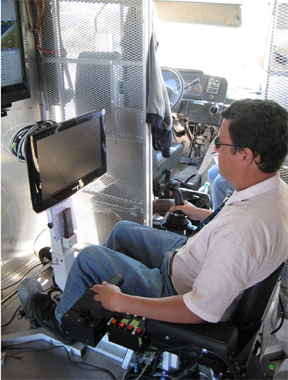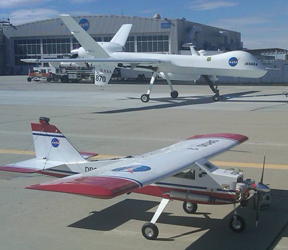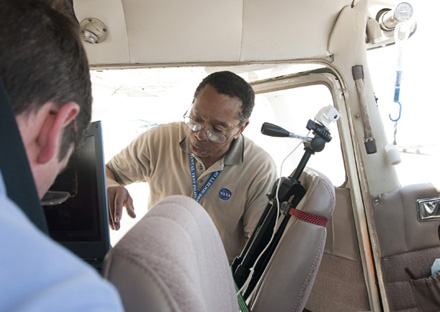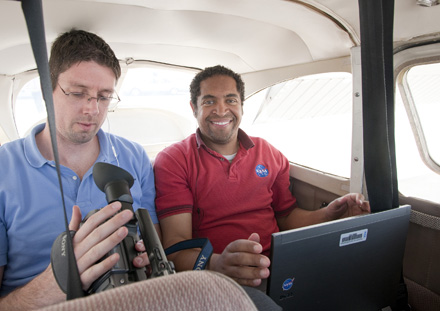By Hernan Posada
NASA Dryden UAV pilot
I have a pretty interesting job here at Dryden. I get the opportunity to fly some great unmanned aircraft and work with some very talented people.
I may be the only pilot signed off in the DROID – Dryden Remotely Operated Integrated Drone – as well as the Ikhana (NASA MQ-9) and Global Hawk (NASA RQ-4). These aircraft all play a vital role in NASA’s research mission but their performance and the way they are flown are very different. The DROID is a very sophisticated platform capable of autonomous flight. Though to the untrained eye it looks like a remote-controlled toy, it really isn’t; it has an autopilot, cameras, a pitot static system and brakes. It is flown through a ground system comprising a series of computers and monitors housed in a “bread van.” This aircraft is flown using “stick and rudder” skills, which basically means the pilot operates a stick to fly it.
Image right: Dryden pilot Hernan Posada flies the DROID from a ground control station.
The Ikhana (a modified Predator) is also flown this way. Pilots fly the Global Hawk, on the other hand, using a keyboard and mouse. The size of these aircraft range from 10-foot wingspan and 57 lbs. (DROID) to a 66-foot wingspan and 10,500 lbs. (Ikhana) to a 116-foot wingspan and 25,600 lbs. (Global Hawk). There are all kinds of missions; local DROID flights are flown at altitudes of just 1,000 feet and less than one hour over the small UAS airspace here at Edwards. Ikhana missions vary, but may have the aircraft flying fire missions over the western United States at altitudes over 20,000 feet and for up to 20 hours at a time. The Global Hawk has seen missions over the Arctic, the Pacific and the Atlantic, altitudes of over 60,000 feet and missions lasting more than 20 hours.
Amazing platforms are being flown here at Dryden, and the technology is constantly being improved. Keep an eye on the fascinating world of unmanned aircraft!
Image left: The red-and-white DROID is parked on Dryden’s ramp along with one of NASA Dryden’s airborne science UAVs, the Ikhana.

 We set up a laptop and webcam in a Cessna 172 for a flight over the Antelope Valley. We installed an Internet “hotspot” in the plane and established an Internet connection with the class before takeoff by using free Skype video-conferencing software. Before the flight, via a NASA Digital Learning Network link-up, Dryden operations engineer Callie Holland explained the purpose and techniques used in a real-world control room so the students would understand what they were about to do. Then she gave them our pilot test cards, which had blank spaces in which students could copy the climb, cruise and turn performance data in real time during the flight.
We set up a laptop and webcam in a Cessna 172 for a flight over the Antelope Valley. We installed an Internet “hotspot” in the plane and established an Internet connection with the class before takeoff by using free Skype video-conferencing software. Before the flight, via a NASA Digital Learning Network link-up, Dryden operations engineer Callie Holland explained the purpose and techniques used in a real-world control room so the students would understand what they were about to do. Then she gave them our pilot test cards, which had blank spaces in which students could copy the climb, cruise and turn performance data in real time during the flight. Image left: Dryden Distance Learning Network coordinator David Alexander, right, and Shaun Smith from the Dryden education office provide support (from the back seat) for the digital link-up that made the project possible.
Image left: Dryden Distance Learning Network coordinator David Alexander, right, and Shaun Smith from the Dryden education office provide support (from the back seat) for the digital link-up that made the project possible.